The KDM4B-CCAR1-MED1 axis is a critical regulator of osteoclast differentiation and bone homeostasis
- PMID: 34031372
- PMCID: PMC8144413
- DOI: 10.1038/s41413-021-00145-1
The KDM4B-CCAR1-MED1 axis is a critical regulator of osteoclast differentiation and bone homeostasis
Abstract
Bone undergoes a constant and continuous remodeling process that is tightly regulated by the coordinated and sequential actions of bone-resorbing osteoclasts and bone-forming osteoblasts. Recent studies have shown that histone demethylases are implicated in osteoblastogenesis; however, little is known about the role of histone demethylases in osteoclast formation. Here, we identified KDM4B as an epigenetic regulator of osteoclast differentiation. Knockdown of KDM4B significantly blocked the formation of tartrate-resistant acid phosphatase-positive multinucleated cells. Mice with myeloid-specific conditional knockout of KDM4B showed an osteopetrotic phenotype due to osteoclast deficiency. Biochemical analysis revealed that KDM4B physically and functionally associates with CCAR1 and MED1 in a complex. Using genome-wide chromatin immunoprecipitation (ChIP)-sequencing, we revealed that the KDM4B-CCAR1-MED1 complex is localized to the promoters of several osteoclast-related genes upon receptor activator of NF-κB ligand stimulation. We demonstrated that the KDM4B-CCAR1-MED1 signaling axis induces changes in chromatin structure (euchromatinization) near the promoters of osteoclast-related genes through H3K9 demethylation, leading to NF-κB p65 recruitment via a direct interaction between KDM4B and p65. Finally, small molecule inhibition of KDM4B activity impeded bone loss in an ovariectomized mouse model. Taken together, our findings establish KDM4B as a critical regulator of osteoclastogenesis, providing a potential therapeutic target for osteoporosis.
Conflict of interest statement
The authors declare no competing interests.
Figures
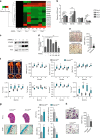

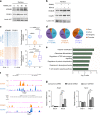
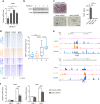

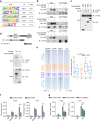
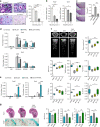
Similar articles
-
Tricarboxylic Acid Cycle Regulation of Metabolic Program, Redox System, and Epigenetic Remodeling for Bone Health and Disease.Antioxidants (Basel). 2024 Apr 17;13(4):470. doi: 10.3390/antiox13040470. Antioxidants (Basel). 2024. PMID: 38671918 Free PMC article. Review.
-
Leonurine hydrochloride inhibits osteoclastogenesis and prevents osteoporosis associated with estrogen deficiency by inhibiting the NF-κB and PI3K/Akt signaling pathways.Bone. 2015 Jun;75:128-37. doi: 10.1016/j.bone.2015.02.017. Epub 2015 Feb 21. Bone. 2015. PMID: 25708053
-
Inhibition of the histone demethylase KDM4B leads to activation of KDM1A, attenuates bacterial-induced pro-inflammatory cytokine release, and reduces osteoclastogenesis.Epigenetics. 2018;13(5):557-572. doi: 10.1080/15592294.2018.1481703. Epub 2018 Aug 7. Epigenetics. 2018. PMID: 29927684 Free PMC article.
-
Coenzyme q10 regulates osteoclast and osteoblast differentiation.J Food Sci. 2013 May;78(5):H785-891. doi: 10.1111/1750-3841.12116. Epub 2013 Apr 12. J Food Sci. 2013. PMID: 23582186
-
The Diverse Roles of Histone Demethylase KDM4B in Normal and Cancer Development and Progression.Front Cell Dev Biol. 2022 Feb 2;9:790129. doi: 10.3389/fcell.2021.790129. eCollection 2021. Front Cell Dev Biol. 2022. PMID: 35186950 Free PMC article. Review.
Cited by
-
Preliminary identification of somatic mutations profile in ACL injury.Sci Rep. 2024 Oct 1;14(1):22847. doi: 10.1038/s41598-024-73718-9. Sci Rep. 2024. PMID: 39354002 Free PMC article.
-
Tricarboxylic Acid Cycle Regulation of Metabolic Program, Redox System, and Epigenetic Remodeling for Bone Health and Disease.Antioxidants (Basel). 2024 Apr 17;13(4):470. doi: 10.3390/antiox13040470. Antioxidants (Basel). 2024. PMID: 38671918 Free PMC article. Review.
-
Angelicin improves osteoporosis in ovariectomized rats by reducing ROS production in osteoclasts through regulation of the KAT6A/Nrf2 signalling pathway.Chin Med. 2024 Jul 2;19(1):91. doi: 10.1186/s13020-024-00961-7. Chin Med. 2024. PMID: 38956695 Free PMC article.
-
Epigenetic Regulation of NGF-Mediated Osteogenic Differentiation in Human Dental Mesenchymal Stem Cells.Stem Cells. 2022 Sep 26;40(9):818-830. doi: 10.1093/stmcls/sxac042. Stem Cells. 2022. PMID: 35728620 Free PMC article.
-
KDM4B: A promising oncology therapeutic target.Cancer Sci. 2024 Jan;115(1):8-16. doi: 10.1111/cas.16005. Epub 2023 Nov 3. Cancer Sci. 2024. PMID: 37923555 Free PMC article. Review.
References
LinkOut - more resources
Full Text Sources
Other Literature Sources
Molecular Biology Databases

